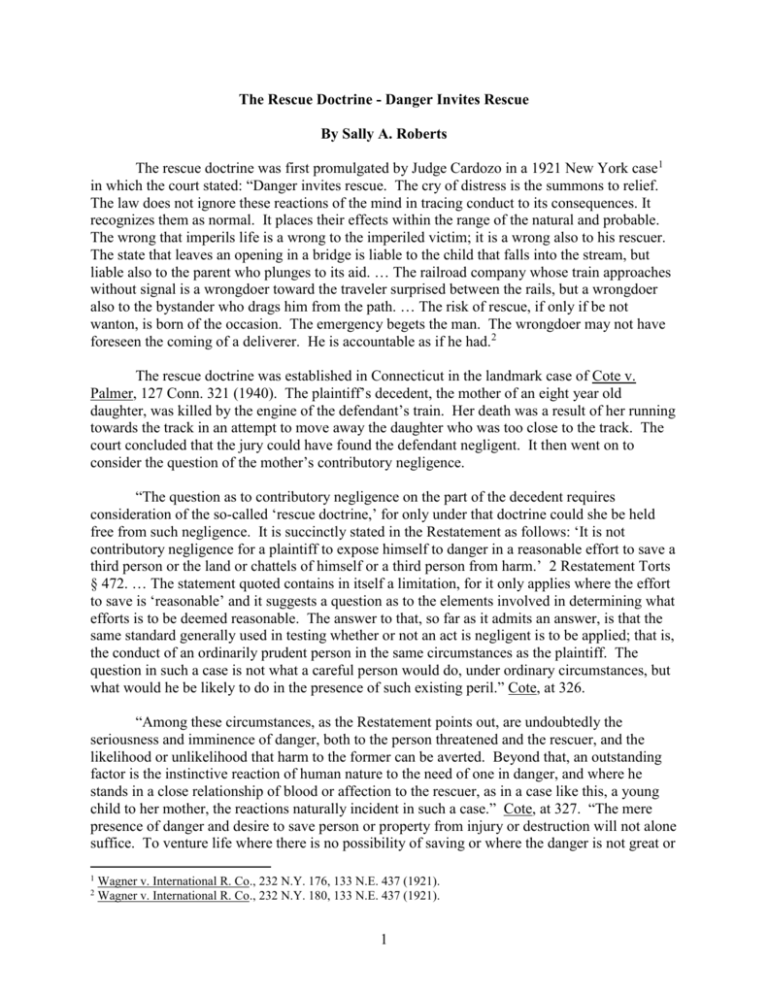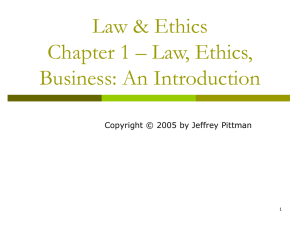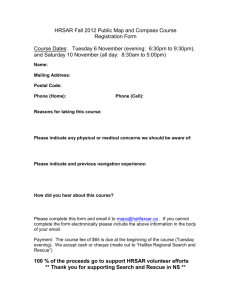The Rescue Doctrine - Sally A. Roberts Law Firm
advertisement

The Rescue Doctrine - Danger Invites Rescue By Sally A. Roberts The rescue doctrine was first promulgated by Judge Cardozo in a 1921 New York case1 in which the court stated: “Danger invites rescue. The cry of distress is the summons to relief. The law does not ignore these reactions of the mind in tracing conduct to its consequences. It recognizes them as normal. It places their effects within the range of the natural and probable. The wrong that imperils life is a wrong to the imperiled victim; it is a wrong also to his rescuer. The state that leaves an opening in a bridge is liable to the child that falls into the stream, but liable also to the parent who plunges to its aid. … The railroad company whose train approaches without signal is a wrongdoer toward the traveler surprised between the rails, but a wrongdoer also to the bystander who drags him from the path. … The risk of rescue, if only if be not wanton, is born of the occasion. The emergency begets the man. The wrongdoer may not have foreseen the coming of a deliverer. He is accountable as if he had.2 The rescue doctrine was established in Connecticut in the landmark case of Cote v. Palmer, 127 Conn. 321 (1940). The plaintiff’s decedent, the mother of an eight year old daughter, was killed by the engine of the defendant’s train. Her death was a result of her running towards the track in an attempt to move away the daughter who was too close to the track. The court concluded that the jury could have found the defendant negligent. It then went on to consider the question of the mother’s contributory negligence. “The question as to contributory negligence on the part of the decedent requires consideration of the so-called ‘rescue doctrine,’ for only under that doctrine could she be held free from such negligence. It is succinctly stated in the Restatement as follows: ‘It is not contributory negligence for a plaintiff to expose himself to danger in a reasonable effort to save a third person or the land or chattels of himself or a third person from harm.’ 2 Restatement Torts § 472. … The statement quoted contains in itself a limitation, for it only applies where the effort to save is ‘reasonable’ and it suggests a question as to the elements involved in determining what efforts is to be deemed reasonable. The answer to that, so far as it admits an answer, is that the same standard generally used in testing whether or not an act is negligent is to be applied; that is, the conduct of an ordinarily prudent person in the same circumstances as the plaintiff. The question in such a case is not what a careful person would do, under ordinary circumstances, but what would he be likely to do in the presence of such existing peril.” Cote, at 326. “Among these circumstances, as the Restatement points out, are undoubtedly the seriousness and imminence of danger, both to the person threatened and the rescuer, and the likelihood or unlikelihood that harm to the former can be averted. Beyond that, an outstanding factor is the instinctive reaction of human nature to the need of one in danger, and where he stands in a close relationship of blood or affection to the rescuer, as in a case like this, a young child to her mother, the reactions naturally incident in such a case.” Cote, at 327. “The mere presence of danger and desire to save person or property from injury or destruction will not alone suffice. To venture life where there is no possibility of saving or where the danger is not great or 1 2 Wagner v. International R. Co., 232 N.Y. 176, 133 N.E. 437 (1921). Wagner v. International R. Co., 232 N.Y. 180, 133 N.E. 437 (1921). 1 the possibility of loss serious may go beyond the limit of what which is legally permissible. It accords with the analogies of the law to apply the usual standard of conduct, that is, the conduct of an ordinarily prudent person under the same circumstances. The standard is the same upon which contributory negligence is always to be determined, but in a case like the one before us, it necessarily involves such circumstances as those which have been mentioned. Requiring as it does in a situation where a mother loses her life in an effort to save her child from serious injury or death, an understanding of the ultimate springs of human conduct, there is peculiar value in submitting the issue to the judgment of the twelve man or women of the jury, schooled, as they have been, by their various experiences in life. It must be a rare and clear case where a court could override their conclusion.” Cote, at 328. “In the situation before us we have, in the protective instinct of motherhood, one of the strongest incentives to the risk of life; the jury might reasonably conclude that there was imminent danger of death or serious bodily injury to the child and an instinctive reaction to that danger on the part of the mother; and had the child actually come upon the track in the face of the approaching train, the mother would have barely failed to reach her before it would have been too late. That her sacrifice did not avail to stop the child before she reached the track, cannot be determined from this record; but even if that sacrifice in the ultimate proved unnecessary, that could not affect the decedent’s rights, for they were to be determined upon the facts as she might reasonably have believed them to be. … It is true that there must have been a moment when a calm observer would have seen that she could not reach the child in time to protect her and that unless she immediately stopped she would be struck by the train, but her conduct is to be judged, not in the light of cold reason, but in view of the aroused emotions which would animate a mother situated as was the decedent, and of the lack of opportunity for deliberation and the exercise of cool judgment. … We cannot hold that, as a matter of law, the decedent’s conduct was not that of a reasonably prudent person in like circumstances, using those words in the sense we have stated.” Cote, at 329-330. The Cote statement of the underlying principles of the rescue doctrine is well established law.3 A Nevada case formulated the rule as follows: “Where a defendant’s negligent act, of commission or omission, has created a condition or situation which involved urgent and imminent peril and danger, to life or property, of himself or of others, those acts of negligence are also negligence in relationship to all others who, in the exercise of ordinary care for their own safety under the circumstances, short of rashness and recklessness, may attempt, successfully or otherwise, to rescue such endangered life or property, by an means reasonably appropriate to the purpose.”4 Under the Nevada rule, the rescuer’s actions must be short of rashness or recklessness. Other cases use wanton conduct to limit the rescuer’s right to invoke the rescue doctrine. The law in Connecticut confines the application of the rescue doctrine to one who makes a reasonable effort to effect a rescue. This follows the rule formulated in 2 Restatement (Second), Torts § 472.5 3 Zimny v. Cooper-Jarrett, Inc., 8 Conn. App. 407 (1986). Turpel v. Sayles, 692 P.2d 1290, 1291 (Nev. 1985). 5 Zimny v. Cooper-Jarrett, Inc., 8 Conn. App. 407, 415 fn1 (1986). 4 2 The rescue doctrine applies under Connecticut’s comparative negligence statute, regardless of whether the plaintiff-rescuer contributed to the victim’s peril. In Zimny v. CooperJarrett, Inc., 8 Conn. App. 407 (1986), the plaintiff’s decedent was struck by a vehicle while attempting to help her mother out of the car after being involved in a multiple-car accident. The court examined the application of the rescue doctrine in view of comparative negligence and held that if a rescue attempt is unreasonable, the rescuer should not be barred from recovering, but the amount of recovery should be reduced “by the degree to which he is comparatively negligent.” Zimny, at 420. The court noted that the effect of the rescue doctrine under comparative negligence principles is different than under contributory negligence in that the rescue doctrine no longer serves the purpose of eliminating the absolute defense of contributory negligence. 6 6 See generally Jennifer Noya, The Application of the Rescue Doctrine under Comparative Negligence Principles, 23 N.M. L. Rev. 349 (1993). 3







